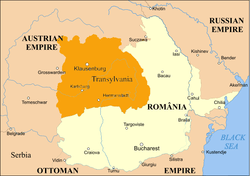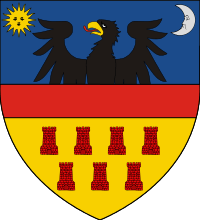Principality of Transylvania (1711–1867)
| (Grand) Principality of Transylvania (Groß)Fürstentum Siebenbürgen (de) Erdélyi (Nagy)Fejedelemség (hu) (Marele) Principat al Transilvaniei (ro) | ||||||
| Crown land of the Habsburg Monarchy and the Austrian Empire (from 1804) | ||||||
| ||||||
| ||||||
 | ||||||
| Capital | Sibiu (Hermannstadt) 1711–1791, 1848–1861 Cluj (Klausenburg) 1791–1848, 1861–1867 | |||||
| Monarch | ||||||
| - | 1711–1740 | Charles III (first) | ||||
| - | 1848-1867 | Franz Joseph I (last) | ||||
| History | ||||||
| - | Rákóczi's Revolt crushed | 1711 | ||||
| - | Immigration of Transylvanian Landler | 1734–1756 | ||||
| - | Revolt of Horea | 1784 | ||||
| - | Hungarian Revolution | 1848 | ||||
| - | Incorporated into Hungary | 1867 | ||||
| Today part of | | |||||
The Principality of Transylvania, from 1765 Grand Principality of Transylvania, was a crown land of the Habsburg Monarchy and a constituent land of the Austrian Empire.
History
In the Great Turkish War the Habsburg Emperor Leopold I had occupied the vassal Ottoman Principality of Transylvania and forced Prince Michael I Apafi to acknowledge his overlordship in his capacity as King of Hungary. Upon his death in 1690, Emperor Leopoeld decreed the Diploma Leopoldinum, which affiliated the Transylvanian territory with the Habsburg Monarchy. In 1697 Michael's son and heir Prince Michael II Apafi finally renounced Transylvania in favour of Leopold; the transfer to the Habsburg lands was confirmed by the 1699 Treaty of Karlowitz between the Holy League and the Ottoman Empire.
After Rákóczi's War of Independence had failed, the Peace of Szatmár was concluded in 1711: Habsburg control over Transylvania was consolidated, and the Princes of Transylvania were replaced with Habsburg imperial governors (Gubernatoren). In 1765 Maria Theresa and her son Emperor Joseph II proclaimed the Grand Principality of Transylvania, consolidating the special separate status of Transylvania within the Habsburg Monarchy, established by the Diploma Leopoldinum in 1691.
From about 1734 onwards, southern Transylvania became the settlement area of German-speaking Transylvanian Landler expellees, Crypto-Protestants from the Habsburg hereditary lands of Upper Austria, Styria and Carinthia, who were exiled to the easternmost outpost of the Habsburg Monarchy. The area around Sibiu (Hermannstadt) had been colonized by Transylvanian Saxons since medieval times; here the Landler had to settle in regions devastated during the Great Turkish War.
The majority of the Transylvanian population was Romanian, many of them peasants working for Hungarian magnates under the precarious conditions of serfdom. The 1784 Revolt of Horea, Cloșca and Crișan, however, and all demands of political equality were of no avail.
During the 1848 Revolutions, the Hungarian insurgents called for the re-unification of Transylvania with Hungary—opposed by Romanian (Wallachian) revolutionaries led by Avram Iancu—, but also for the abolition of serfdom. After the Hungarian revolt was crushed, Transylvania remained under military administration for several years. In 1853, the Transylvanian Military Frontier, which existed from 1762, was abolished and again incorporated into Transylvania.
In 1866 the Transylvanian Diet voted for the affiliation with Hungary, which was accomplished in January 1867. With the subsequent Austro-Hungarian Compromise (Ausgleich), the centuries-long autonomous status of Hungarian nobility, Székelys and Transylvanian Saxons ended and the Grand Principality of Transylvania was incorporated into the Kingdom of Hungary, itself a constituent Land of the Crown of Saint Stephen within the Dual Monarchy.
Borders
Before its abolition in 1867, the Principality of Transylvania bordered the Habsburg Kingdom of Hungary to the northwest and west, the Habsburg Bukovina to the northeast, the Habsburg Military Frontier to the southwest, and the United Principalities of Moldavia and Wallachia to the south and east.
Demographics
| Year | Total | Romanians | Hungarians and Székelys | Germans |
|---|---|---|---|---|
| 1720 | 806,221 | 49.6% | 37.2% | 12.2% |
| 1730 | ~725,000 | 57.9% | 26.2% | 15.1% |
| 1765 | ~1,000,000 | 55.9% | 26% | 12% |
| 1784 | 1,440,986 | - | - | - |
| 1790[1] | 1,465,000 | 50.8% | 30.4% | - |
| 1835 | - | 62.3% | 23.3% | 14.3% |
| 1850 | 2,073,372 | 59.1% | 25.9% | 9.3% |
Governors
See also
References
- ↑ Peter Rokai – Zoltan Đere – Tibor Pal – Aleksandar Kasaš, Istorija Mađara, Beograd, 2002, pages 376–377.

